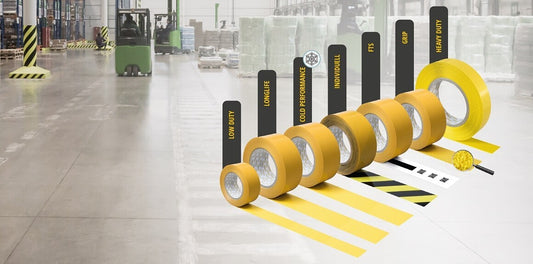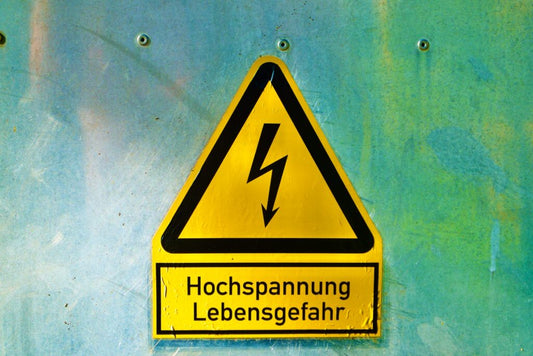Workplace symbols create instantly recognisable and meaningful statements at a glance. Using visibility, logical reasoning and clever use of semiotics, the signage industry has boomed over the past 100 years.
The Health and Safety Executive for the UK states that 123 workers were killed between 2021 and 2022 with a further 565,000 being injured in the workplace. Work safety is still an important matter to consider here in 2023. We are going to take a look at how signmakers codify meaning in the workplace to help keep everyone safe.
Defying language and technical understanding, sign makers have used symbology to make places of work safer and more efficient and easier to understand for everyone. It stands to reason that they are properly used and understood by those in charge to correctly use quick identifiers to clearly show intent or warning in areas of danger or frequent use.
But, what are the most important signs in a workshop? Signage differs depending on the needs of a workshop, but several standards must be kept to ensure that everyone is safe when using machinery. The most commonly used signs in a workshop are:
- Wall Signs
- Floor Signs
- Fire Exit Signs
- Hazard Symbols
Read on to learn more about these symbols and signs in a workshop and how you can get the most out of your workshop signage to best keep your staff and others safe with Orgatex, a world leader in workshop and warehouse safety and efficiency.
The Importance Of Safety Signs in a Workshop
There are a few key areas in a workshop that can have signage added to keep people safe and deliver a message. Employers are duty-bound by law to include signs that indicate significant risks that can’t be avoided. Safety signs aren’t needed if they are deemed to not reduce the risk of harm to those who work nearby, or if the significance of the risk is deemed to be minimal.
There are some places where safety signage is crucial for issuing a clear indication of risk in the workplace. These areas include:
- Areas where heavy machinery is in use.
- Areas that impose risk from above or below.
- Areas of high frequency
Signs must be presented to be read and understood by everyone working in that area. They are used to show prohibited actions, relative risks or resources to work being carried out in that area. Some examples commonly found in workplaces are:
- Prohibitive - a sign that stops a behaviour that is likely to cause harm such as ‘No Access’
- Warning - a sign used to give a clear indication of the danger or hazard you need to consider such as ‘Hazardous Materials - Corrosive’
- Mandatory - a sign that prescribes a particular behaviour such as ‘Ear Protection Must Be Worn’
- Emergency or First Aid - a sign used to indicate what to do or where to go in the outcome of an emergency such as ‘Fire Exit’
You will have come across these during your normal workday, and they are being standardised throughout the UK and EU. This means that whatever country you work in, or from whatever country you have been trained, these signs should hopefully be recognisable.

The Colour and Symbols Of Signs in a Workshop
The way that colour and symbols are used in signs are considered intrinsic features that must be used in the UK to provide sufficient information to those who are viewing them.
Colour
The use of colours for signage in a workshop is a simple use of symbology that helps to designate the sign's intent to the reader, even if they are unaware of the rule itself.
If you find yourself in a situation where you need to follow a fire exit, you won’t have time to read detailed instructions about where the fire exits are located. Signmakers use colour to indicate intent as a shorthand in situations involving risk.
The way that signmakers indicate what risks are a hazard is by using the following
Colours:
- Red is Prohibitive.
- Yellow indicates a Warning.
- Blue denotes a Mandatory Behaviour.
- Green is used for indicating an Emergency Procedure.
Using colour in this way saves time and easily communicates intent to the reader. The Health and Safety Executive for the UK notes that each image must be made up of at least 35% of the designated colour on each Prohibitive sign. This is with a black symbol that is designed to instruct on the action for which the sign is intended. Others, such as Warning signs must be at least 50% yellow with black symbols.

Symbols
Using symbols is a great way to give short-hand instructions. Sometimes referred to as ‘pictograms’, these small symbols are used to represent a short idea that is clear and understandable to the person viewing it.
Like much of the above, these symbols are standardised where they can be to consistently indicate risk. Some symbols, however, carry an additional meaning which can be displayed through a simple gesture or pictogram.
In these cases, the Health and Safety Executive (regulation 5) instructs all employers must ensure that any additional information relating to connection with safety standards is provided to each of their employees.
With this, the regulations also state that the employer must ensure that the employee receives suitable and sufficient instruction and training for safety signs and the measures to be taken in connection with safety signs.
Industrial Labelling & Workshop Safety Signs From Orgatex
Industrial labelling is key for businesses that can’t always rely on constant verbal communication. Sometimes a use of colour or a simple label is sufficient to arrive and an agreed upon meaning. For instance, a colour board, such as those used in the Kanban System can indicate progress in a project using simple colour coding.
Outside of the regulations, you can use signage, symbology and colour schemes to indicate intent or meaning in your workplace. Floor markings are a great use of symbology that can be used to indicate areas for a specific use.
If you consider how important road markings are to the process of driving, they also have a similar effect for use in warehouses, workshops and storage areas. Floor tape can be used to indicate safe areas to walk when heavy machinery is in use. Step symbols can likewise be used to show people where walking is permitted.
Here at Orgatex, we trade Visual Communication systems designed to bring clarity to all industries. Making simple representations of risks, limitations and intentions not only saves time but also makes everyone safer.
Make sure to consider Orgatex for all your solutions for Lean Management in the future.












